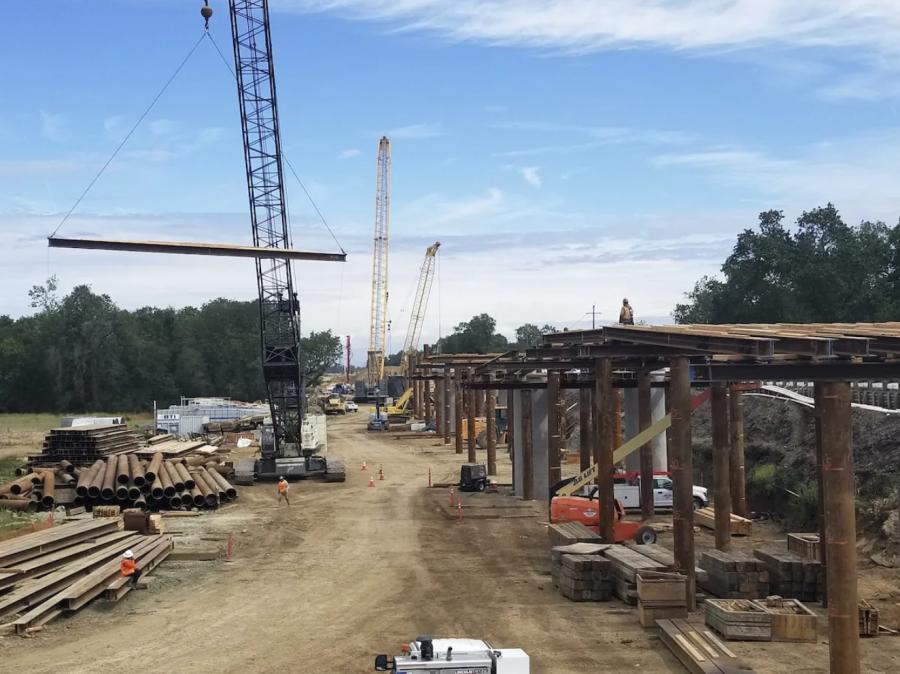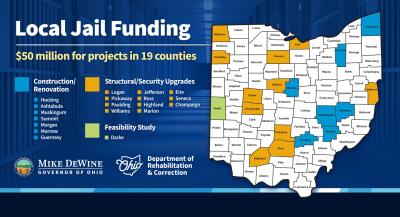The joint venture of Teichert Construction and MCM Construction Inc. is executing numerous upgrades on the State Route 70 Corridor Improvement Project, which includes constructing the longest-ever, single-span bridge designed by Caltrans at 1,400 ft.
(Photo courtesy of Caltrans.)
A joint venture consisting of Teichert Construction and MCM Construction Inc. began construction on the California Department of Transportation's (Caltrans) $63.9 million State Route 70 Corridor Improvement Project in June 2021, which covers the 4-mi. stretch between East Gridley Road to the Butte-Yuba County Line, and is expected to complete the project in summer 2023.
Crews are constructing a new 1,400-ft. bridge with standard lanes and shoulders over Honcut Creek, the longest Caltrans has ever designed, widening the existing two-lane highway to five lanes (two lanes in each direction, with a turning lane in the center); creating a continuous two-way left turn; widening the shoulders to 8 ft.; upgrading the existing drainage systems; and establishing an area for vehicles veering off the roadway to return to the main highway. The passing lane segment, between East Gridley Road and Lower Honcut Road, opened to traffic on Nov. 23, 2022.
The new 1,400-ft. long bridge over Honcut Creek will have two westbound lanes with 8-ft. wide shoulders. The existing bridges cover eastbound traffic.
"It's a single-span bridge — the longest single-span structure that Caltrans has designed and built," said Danny Warren, Teichert's project executive. "We started with the foundation work in the middle and then worked towards one side and then the other based on the dimensions of the piles and the equipment that MCM needed to construct them and the foundations. Once the foundation work was complete, they did something similar for the deck pours."
A fair number of piles were drilled.
"Not counting the abutments for the pier," said Warren, "there were 14 foundation CIHD piles ranging from 100 to 150 feet deep, and some of them were eight and 10 feet in diameter. There were two abutments and each one had 12 24-inch piles."
The falsework included a temporary trestle constructed over the creek.
"It was set upon the field piles and on the floor off of the soffits of the bridge deck," said Warren, who stressed that meticulous planning was required to construct the bridge with all of the challenges associated with the work.
Project Progress
At this point, the JV has made considerable strides work-wise, with Teichert constructing the road element and MCM building the bridge.
"MCM has made good progress," said Warren. "The bridge deck is all poured out and they are working on stressing the deck over the next couple of weeks. Then they'll work on wrapping up the abutment deck wall and barrier walls on the bridge. Roadwork-wise, we've completed the drainage systems and just under three miles north of the roadway. We're putting the touches on that and once it is complete, we will be able to move traffic across the new bridge so we can complete the last bit of the roadway surrounding the existing bridges for the current traffic pattern."
Despite the fast-track nature of the schedule, crews are pushing forward.
"We got started in last September [2021] and we had to import fill, which was set back a little bit with some of the crazy rain events we had last year," Warren said. "We got one in October that caused a little bit of flooding in the area and then we caught some more around Christmas that held it up, but we pushed through and we got a good early start on the work this season that allowed us to get three miles of new road built. We finished paving it in mid-November. Most of the work is taking place during the day, although there is some night work when we have to restrict traffic to one lane with flagging.
The new bridge has been built through a flood plain and there were some environmental timing restrictions that the contractor had to work around, according to Warren.
"Once the bridge is stressed, they can release the falsework and get out of the floodplain," Warren said. "We did not really have any utility issues where we are working. There are very few existing utilities, save for Caltrans electrical wiring for lighting and intersections. We've modified these already."
There are some giant garter snakes living in the project area which, according to Wikipedia, is "relatively rare, it is a semi-aquatic snake with a limited distribution in the wetlands of central California." This led to some timing restrictions for the schedule.
"There also is an osprey nest adjacent to the project that posed a challenge," said Warren, "but working with Caltrans environmental team and our biologists, we observed those and worked safely around those without disturbing their nesting period. We have a good relationship with the Caltrans road construction team. We have successful quarterly partnering meetings and weekly progress meetings, which helps and provides full-time communications."
Teichert and MCM have a good amount of room for the road work.
"We were essentially building three new lanes adjacent to the existing lanes, just west of them," said Warren. "The bridge site is a little bit tight because we're building a new bridge next to the existing three bridges, and then there is the environmentally sensitive area to the west of the bridge. The workspace is somewhat limited, but we managed to do what was needed to get it done."
Road Work Construction
For the road work, traffic was shifted and K-rail was placed to separate traffic from the crews. Once the new lanes were built, traffic was shifted to allow crews to reconstruct the existing lanes.
Teichert had one crew engaged in grading and earth work, a second crew that installed all of the drainage systems and a paving crew poured the asphalt.
"There was a lot of clearing and grubbing that had to take place prior to the earth work," said Warren. "We had to import almost 90,000 cubic yards of fill material to build the new abutments and then we had another 50,00 cubic yards of roadway excavation — moving dirt around on-site to build the new roadway section. Then we imported about 100,000 tons of Class 2AB base rock for the road section and we placed 52,000 tons of dense grade asphalt and 20,000 tons of rubberized asphalt."
The base section is 1.5 ft. and the asphalt topping is 9 in. The newly paved areas were ready to take traffic by the end of the shift. The excavated material was re-used on-site.
Teichert is using mainly Cat equipment for the road work, which included a 14M motor grader, a skid tractor, 352 and 336 excavators, 815 and 825 pad drum rollers for compacting and D6 and D8 dozers for the maintenance builds. The motor grader and dozers were equipped with Trimble GPS systems.
The roadwork included new 8-ft. wide shoulders on each side.
The drainage work had crews install corrugated metal pipe.
"Most of that is just across the highway," said Warren. "There is a new drainage ditch on the left side of the highway. We brought in all the pipe at once, staged it there and we installed all the storm drain systems in two separate [phases]."
The area for vehicles veering off the roadway to return to the main highway was part of the safety improvements, along with the wider shoulders.
"It's graded at two to one for a certain width for Caltrans to have a clear recovery zone that gives motorists time to recover should they veer off the highway or when mechanical failures occur," said Warren. "That was all built up with grading work. We excavated the ditch, shaped the shoulders up and then built the roadway section, working from the outside in."
The MCM and Teichert management teams worked well together.
"The dynamic of the two teams was very good," said Warren. "We've been working together very well. Our work overlaps a little bit, so there is a lot of communication and coordination to keep us on track. There have been a few times when we helped each other out. We've had to borrow their forklifts once or twice and we moved some items for them. The efforts of both crews have been tremendous. They accomplished a huge amount of work in a very short period of time. The quality is excellent thus far and going really well."
Peak days have had 40 to 50 people working on the bridge and more than 20 for the road work. Local and regional subcontractors were brought on board by both JV partners. CEG
Irwin Rapoport
A journalist who started his career at a weekly community newspaper, Irwin Rapoport has written about construction and architecture for more than 15 years, as well as a variety of other subjects, such as recycling, environmental issues, business supply chains, property development, pulp and paper, agriculture, solar power and energy, and education. Getting the story right and illustrating the hard work and professionalism that goes into completing road, bridge, and building projects is important to him. A key element of his construction articles is to provide readers with an opportunity to see how general contractors and departments of transportation complete their projects and address challenges so that lessons learned can be shared with a wider audience.
Rapoport has a BA in History and a Minor in Political Science from Concordia University. His hobbies include hiking, birding, cycling, reading, going to concerts and plays, hanging out with friends and family, and architecture. He is keen to one day write an MA thesis on military and economic planning by the Great Powers prior to the start of the First World War.
Read more from Irwin Rapoport here.
Today's top stories



















